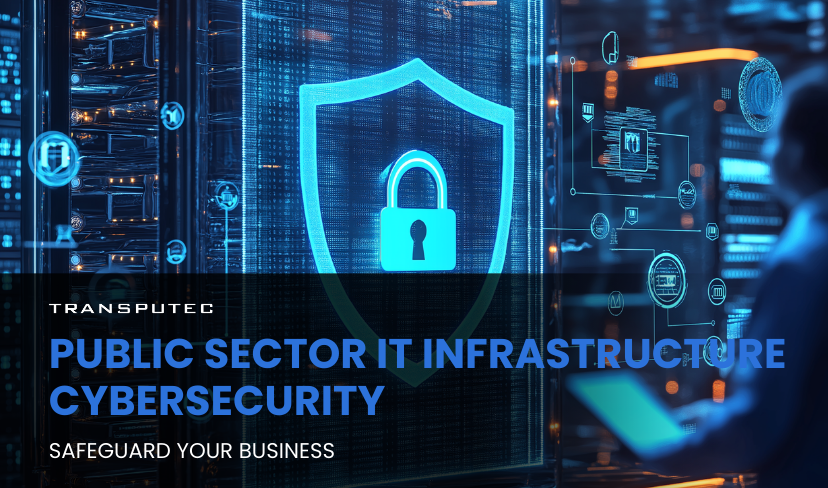Written by KRITIKA SINHA | MARKETING
When outdated servers crash mid-process, security patches get delayed for months, and sensitive citizen data is stored on vulnerable systems, the real cost isn’t just financial — it’s public trust. In the public sector, employees and stakeholders often find themselves battling with sluggish systems, growing cyber threats, and insufficient IT support, all while under the pressure of delivering critical services. These issues expose a glaring gap in Public Sector IT Infrastructure — one that could lead to devastating consequences if left unaddressed.
This blog explores the current challenges in securing public sector IT environments, identifies vulnerabilities that are commonly overlooked, and highlights how Transputec’s tailored cybersecurity services are helping public bodies future-proof their infrastructure. You’ll gain actionable insights backed by data, expert strategies, and a practical way forward to ensure your IT systems are resilient, compliant, and secure.
The State of Public Sector IT Infrastructure
Mounting Technical Debt
According to a 2023 UK government report, 45% of public sector IT systems are over a decade old, leaving them vulnerable to modern cyberattacks. Legacy systems accumulate “technical” debt”—the longer you postpone upgrades, the costlier and riskier they become. These outdated technologies limit integration, hinder agility, and expose data to unnecessary threats.
Cyberattacks on the Rise
The National Cyber Security Centre (NCSC) reported a 47% rise in ransomware attacks targeting UK public sector institutions between 2022 and 2023. Health trusts, local councils, and government bodies have all suffered significant operational and reputational damage. These attacks often exploit weak spots in Public Sector IT Infrastructure, such as unpatched systems and poor identity management.
Why Public Sector IT Infrastructure Is a High-Value Target
1. Data Sensitivity and Volume
Public bodies handle vast quantities of personally identifiable information (PII)—tax records, healthcare data, and legal documents — making them attractive targets for ransomware attacks and identity theft.
2. Critical Service Dependency
Public services like emergency response, healthcare, and local councils rely on functioning IT systems. Any compromise can disrupt essential services and endanger lives.
3. Slow Procurement Processes
Budgeting and procurement cycles are often lengthy, causing delays in acquiring modern technologies or essential cybersecurity tools.
4. Regulatory Pressure
Government organisations must adhere to strict compliance mandates like GDPR, FOIA, and accessibility standards, making failure more consequential.
5. Visibility Gaps in Infrastructure
Public sector entities often lack real-time visibility into their full IT infrastructure, creating blind spots for emerging threats.
Core Challenges in Public Sector IT Infrastructure Security
1. Outdated Legacy Systems
These systems are not only insecure but also incompatible with modern tools and updates. This restricts integration with newer platforms and software.
2. Limited Budget Allocation
Many public sector departments lack sufficient funding for cybersecurity, resulting in minimal investment in upgrades and protection.
3. Fragmented IT Environments
Disparate systems across departments, without centralised oversight, create inconsistencies and vulnerabilities.
4. Third-Party and Supply Chain Risks
Dependency on vendors without proper security vetting exposes the organisation to indirect cyber threats.
5. Underdeveloped Cyber Awareness
Many employees aren’t trained to identify phishing attempts, weak password usage, or shadow IT practices — increasing internal risk vectors.
Ready to Take Your Business's Security to the Next Level?
Connect with us today for our free consultation!
Future-Proofing Public Sector IT Infrastructure
1. Adopt Cloud-Native Technologies
Cloud platforms offer cost savings, built-in security, and easier maintenance — critical for public sector agility.
2. Zero Trust Security Model
By default, trust no one. All users and devices must be verified continuously, reducing insider threats and lateral movement by attackers.
3. Automation of Routine IT Tasks
Automating backups, patching, and log analysis frees up internal teams and ensures the timely execution of security tasks.
4. Cybersecurity Skills Development
Upskilling internal staff ensures better incident detection, response, and overall security culture.
5. Data Backup and Disaster Recovery Planning
Transputec helps build resilient infrastructure with secure backups and well-tested disaster recovery plans for business continuity.
Things You Can Do Today to Improve IT Infrastructure Security
1. Conduct a Full Risk Assessment
Identify vulnerabilities, outdated software, and insecure access points before they become entryways for cybercriminals.
2. Segment Your Network
Isolate sensitive data and services so a breach in one area doesn’t give access to everything.
3. Deploy Security Monitoring Tools
Tools like intrusion detection systems (IDS) and endpoint detection and response (EDR) add proactive layers of defence.
4. Enforce Strong Access Controls
Implement the principle of least privilege (PoLP), ensuring users only have access to what they need.
5. Regularly Test Your Systems
Run penetration tests and simulated phishing campaigns to uncover gaps and raise employee awareness.
How Transputec Strengthens Public Sector IT Infrastructure Security
A Trusted Partner in Cybersecurity
Transputec brings over 35 years of experience in delivering managed IT and cybersecurity services tailored to the needs of the public sector. Their consultative approach ensures that every solution is aligned with organisational goals, risk profiles, and compliance requirements.
Key Services Offered by Transputec:
24/7 Cyber Threat Monitoring: Using advanced SIEM tools and a dedicated Security Operations Centre (SOC), Transputec detects and neutralises threats in real-time.
Infrastructure Modernisation: Migration from legacy systems to scalable cloud or hybrid solutions, reducing downtime and vulnerabilities.
Risk Assessment & Penetration Testing: Thorough testing uncovers system weaknesses before malicious actors do.
Compliance Advisory: Support for GDPR, NIST, ISO, and other regulatory frameworks.
Incident Response & Recovery: In the event of an attack, Transputec offers swift containment, investigation, and recovery services.
Conclusion
Securing public sector IT infrastructure is not just about protecting data; it’s about ensuring the continuity of essential services and maintaining public trust. The increasing complexity of cyber threats makes it imperative for public sector organisations to invest in robust cybersecurity measures. Transputec’s comprehensive cybersecurity services offer a solution to these challenges, helping public sector entities safeguard their digital assets and comply with regulatory requirements.
Are you ready to secure your public sector IT infrastructure? Contact us today to connect with an expert and get started with Transputec. Our team is here to help you navigate the complexities of cybersecurity and ensure your organisation’s digital assets are protected.

Secure Your Business!
Ready to explore how we can enhance your security posture? Contact us today to speak with one of our experts.
FAQs
1. What makes Public Sector IT Infrastructure more vulnerable to cyber threats?
Public sector infrastructure often includes outdated systems and lacks modern cybersecurity protocols due to tight budgets, complex procurement cycles, and limited internal expertise. These factors create exploitable weaknesses that malicious actors can target.
2. How does Transputec help improve Public Sector IT Infrastructure?
Transputec provides end-to-end services, including real-time threat monitoring, cloud migration, compliance support, and legacy system upgrades. They tailor each solution to the organisation’s specific goals, ensuring robust security and operational efficiency.
3. What kind of cybersecurity solutions does Transputec offer?
Transputec offers a range of services, such as SIEM integration, Security Operations Centre (SOC) support, penetration testing, incident response, and zero trust architecture implementation — all designed to secure public sector IT infrastructure.
4. How do I know if my organisation’s IT infrastructure is outdated?
If your systems are over 5–10 years old, frequently experience downtime, or require extensive manual workarounds, it’s likely time for an infrastructure audit. Transputec can conduct a full assessment and recommend a path forward.
5. Can Transputec assist with compliance with regulations like GDPR?
Yes. Transputec helps public sector clients understand and meet compliance requirements, including GDPR, ISO 27001, and other frameworks. Their team ensures your IT infrastructure supports secure, lawful, and auditable data handling.







